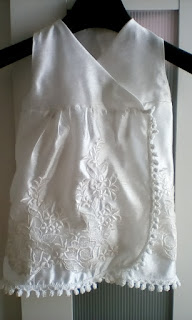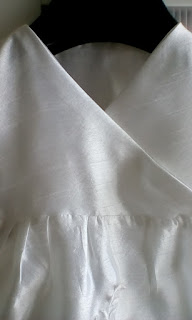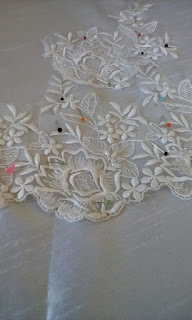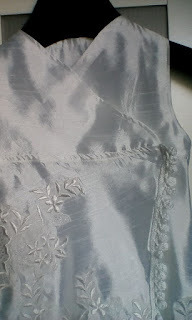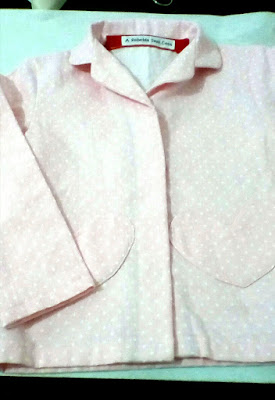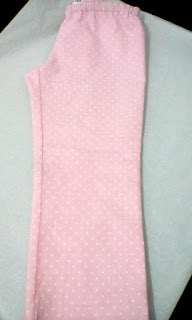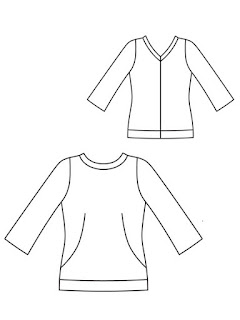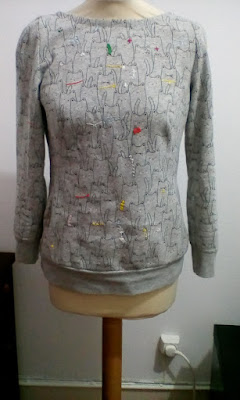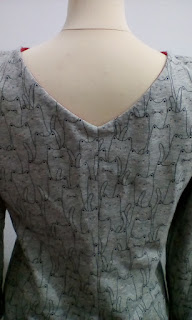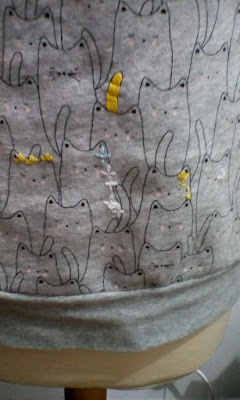A minha última ida ao Porto foi bastante produtiva. Além de ter comprado o tecido de flanela para o pijama que mostrei anteriormente, consegui ainda comprar um vestido de noiva, que tinha visto no OLX há já alguns meses, pela módica quantia de...10€ (não, não estou a brincar).
Last time I visited Oporto, I bought the flannel fabric for the girl's pj I blogged about this month. I also scored a wedding gown, that I'd found on a advertisement site some months earlier, for 10€!!!
Last time I visited Oporto, I bought the flannel fabric for the girl's pj I blogged about this month. I also scored a wedding gown, that I'd found on a advertisement site some months earlier, for 10€!!!
Adoro reaproveitar roupa e achei que por 10€ iria conseguir uma quantidade jeitosa de tecido e renda. E assim foi! O vestido estava em bom estado, sem qualquer dano (geralmente, as bainhas destes vestidos ficam estragadas de serem arrastadas e pisadas durante todo o dia do casamento) e apenas a precisar de ser lavado antes de ganhar uma nova vida. Fechava atrás com botões forrados e argolinhas.
I LOVE to upcycle clothing and thought that for 10€, I would get a nice amount of fabric and lace. I wasn't wrong! The dress was in good condition, without any damages (usually the hems of this kind of dress are ruined from being dragged and stepped on during the wedding day) and just needed to be washed. It closed on the back with buttons and loops.
Era um vestido de estilo tradicional - costuras princesa na frente, de meia manga, com a frente mais curta que a parte de trás (penso que da cintura ao chão, media 1,30m e 1,50m respetivamente), com aplicação de renda na bainha. Entre o forro e a saia exterior, existia uma camada de tule com dois folhos sobrepostos na bainha, para dar volume à saia (foi a única parte que não aproveitei, pois não em bom estado).
It was a traditional dress - princess seams on the front, mid sleeve, shorter on the front and longer on the back (I think it measure, from the waist down, 1,30cm -front- and 1,50m - back). Between the lining and outer fabric, there as a layer of tulle, with two ruffle on the hem in order to give volume to the skirt. I didn't kept the tulle, it wasn't in good shape.
I LOVE to upcycle clothing and thought that for 10€, I would get a nice amount of fabric and lace. I wasn't wrong! The dress was in good condition, without any damages (usually the hems of this kind of dress are ruined from being dragged and stepped on during the wedding day) and just needed to be washed. It closed on the back with buttons and loops.
It was a traditional dress - princess seams on the front, mid sleeve, shorter on the front and longer on the back (I think it measure, from the waist down, 1,30cm -front- and 1,50m - back). Between the lining and outer fabric, there as a layer of tulle, with two ruffle on the hem in order to give volume to the skirt. I didn't kept the tulle, it wasn't in good shape.
Depois de ter passado uma ou duas horas a descoser a renda da bainha do vestido, cortei-o pela costura da cintura e enfiei a saia do vestido na máquina da roupa! Pensei que se alguma coisa acontecesse, então não valia mesmo a pena reutilizar o tecido (a renda estava em bom estado e foi lavada à mão). Tive sorte e quer o tecido exterior, quer o forro, saíram impecáveis da lavagem.
After spending a couple of hours carefully removing the lace from the hem, cut the dress at the waist seam and threw the skirt of the dress in the washing machine. If something happened to the fabric, then there was no point in sewing it. I was lucky and the main fabric and lining withstanded being machine washed. The lace was handwashed.
After spending a couple of hours carefully removing the lace from the hem, cut the dress at the waist seam and threw the skirt of the dress in the washing machine. If something happened to the fabric, then there was no point in sewing it. I was lucky and the main fabric and lining withstanded being machine washed. The lace was handwashed.
Entretanto, utilizei parte do tecido para o forro de um casaco de bebé (também ele feito a partir de um casaco de senhora) e agora, pela Páscoa, fiz dois vestidos para oferecer a duas bebés, filhas de amigas/familiares. Apenas diferem no comprimento.
Meanwhile, I have used the main fabric to line a baby's jacket (that I made from a women's jacket). More recently, I made two baby dresses to gift around Easter to the daughters of relatives/friends. The only difference between the dresses is the length.
Escolhi este vestido de trespasse e bainha arredondada (tamanho 3T), pois não queria um molde complicado porque 1) tinha pouco tempo para os fazer e 2)queria destacar o tecido e a renda, daí necessitar de um molde com linhas simples. Optei por forrar a parte de cima do vestido e utilizei esta técnica para o fazer sem ter de coser nada à mão.
I chose this wrap dress with a tulip hem (3T) as I didn't have much time to sew the dresses and I wanted to highlight the fabric and lace, so I needed a simple dress, with clean lines. I chose to selfline the bodice, using this technique - no hand sewing!

Meanwhile, I have used the main fabric to line a baby's jacket (that I made from a women's jacket). More recently, I made two baby dresses to gift around Easter to the daughters of relatives/friends. The only difference between the dresses is the length.
I chose this wrap dress with a tulip hem (3T) as I didn't have much time to sew the dresses and I wanted to highlight the fabric and lace, so I needed a simple dress, with clean lines. I chose to selfline the bodice, using this technique - no hand sewing!
Coloquei a renda do vestido acima da bainha dos vestidos, prendi com alfinetes e com ponto zigzag contornei todos os motivos. Se tivesse mais tempo ou se fosse roupa de adulto, prendia a renda como li no blog Fit for a queen - linha vermelha da corta e cose e agulhas longas (é um dos meus blogs preferidos - a autora altera vestidos de noiva e roupa de cerimónia e, além de contar as peripécias que ocorrem no seu atelier, mostra como procede às alterações).
I placed the lace above the hems, pinned it in place and sewed it with a narrow zigzag stich, countohttps://fitforaqueen.wordpress.com/ring all the motifs. If I had more time, I would have basted the lace as I saw on the blog Fit for a queen - with red overlocker/serger thread and a straw needle (this is one of my favourite blogs - the author alters wedding gowns and other formal wear and shows how she alters the clothes. She also talks about the challenges her clients present her).

Em vez de utilizar fita ric rac, lembrei-me de rematar a bainha com fita de pompons e, ao procurá-la na internet, encontrei imagens de pompons feitos em croché. Como tinha comprado uns novelos de linha da Âncora a metade do preço num supermercado, achei que era boa ideia utilizar esse material em vez de ir comprar a fita na retrosaria mais próxima.Encontrei este tutorial e pus mão à obra, pois precisava de cerca de 3m de cordão para os dois vestidos.
Insted of ric rac, I consider to finished the hems with pompom trim. When searching for it online, I came across crochet crochet trim and decided it was a good time to use the balls of crochet yarn that I found at clearance price at a local supermarket. I found this tutorial online and started crocheting.
O problema? Isto foi a uma quinta-feira à tarde e o primeiro vestido tinha de ser feito e posto no correio na segunda-feira, o segundo vestido tinha de ser entregue na quinta-feira seguinte. Com prazos tão apertados, tive mesmo de acelerar e aproveitar todos os bocadinhos para fazer o remate em croché - a hora de almoço, enquanto estava à espera do comboio, no comboio, serões frente à televisão...Os meus pulsos não apreciaram o esforço extra!
The main problem was that I started to crochet on a thursday and the first dress had to be ready to be posted the next monday. The second one was to be delivered the following thursday. With such deadlines, I had to crochet in every single minute I had spare- lunck break at work, on my commute, at the train station, every evening. My wrists didn't enjoy the effort!
As bainhas curvas são sempre mais difíceis de costurar, pelo que utilizo sempre nestes casos esta técnica. Cosi a bainha à máquina e, para aplicar o remate em croché, utilizei um ponto zigzag estreito.
Curved hems are always a challenge,so I always use this technique. I sewed the hem and attached the crochet trim with a narrow zigzag stitch.
No final, correu tudo bem e consegui entregar os vestidos a tempo e o feedback foi positivo! Agora tenho de dar descanso aos pulsos ...
In the end, I got the dresses I had envisioned and the feedback was positive! Now it's time to rest my wrists!
Até à próxima.
See you next time.
